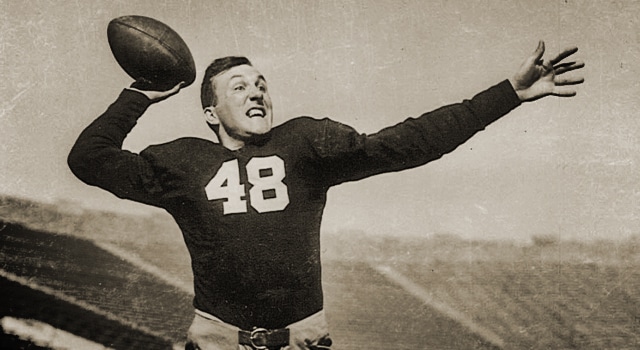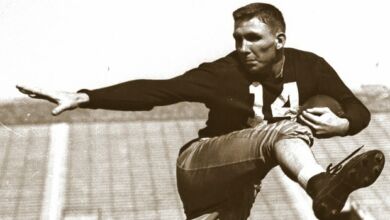
The Heisman Trophy was first awarded in 1935 by New York’s Downtown Athletic Club as the “Downtown Athletic Club Trophy.” John Heisman, the former coach at Georgia Tech, was the athletic director of the DAC and supervised the award program. After Heisman’s death in 1936, the DAC was renamed the “Heisman Memorial Award Trophy,” conveniently remonickered as the “Heisman Trophy.”
It was first awarded to that bellwether of the University of Chicago Maroons, Jay Berwanger, in 1935. Yale players won the next two. In each case one trophy is awarded to the player and one to his school. So the ones you see displayed in the JACC concourse for Notre Dame’s seven winners are duplicates.
Notre Dame came up empty in the first 8 years the Heisman was awarded.
But the field of college football folklore and imagination had been tilled and sowed and nurtured by Knute Rockne, the “Radical traditionalist” of Notre Dame. Rockne had departed from all coaching rules by agreeing to play Army annually in New York City. Rock felt that giving up the home field advantage, while unheard of, was worth the additional exposure, for publicity and recruiting purposes, to the Eastern media. After all, that’s where Grantland Rice worked and he was a “media” unto himself.
Rockne arranged the Irish schedule so that his Ramblers (Leahy’s too) played Army in New York City for 23 years in a row but for one appearance in Soldier Field, in 1930, Rock’s last game against the Cadets.
And in 1926 Rock had created the first, and greatest, intersectional rivalry by agreeing to an annual tilt with Howard Jones’ USC Trojans.
From the banks of the Hudson, East and Harlem Rivers, in Manhattan and the Bronx to the sunny beaches of Los Angeles, Notre Dame had coverage and exposure from sea to shining sea. The “publicity” field was set.
Angelo Bertelli, The Springfield Rifle!
Angelo Bertelli was from “central casting,” a classic notre Dame story. Bertelli was born in West Springfield, Massachusetts to Italian immigrant parents. He matriculated at Springfield’s Cathedral High and was All State in football, baseball and hockey, while finding time to be the Senior class president. He was an “RKG” (Right Kind of Guy) before we knew what an RKG was.
The slender Bertelli, 6’1″ 173 when he entered du lac, was a single wing tailback and fancied himself an accomplished runner as well as passer.
Frank Leahy had made the westward trek from Massachusetts as well, leaving Boston College for the hallowed ground of Notre Dame, a migration that paralleled Bertelli’s. Leahy was smitten with Bertelli’s passing prowess when he arrived in 1941. Amid howls from the self-anointed Notre Dame illuminati, Leahy, loyal first to Rockne’s will to win, the end, adjusted Notre Dame’s means and switched from the single-wing like “box formation” to the split T. Faux traditionalists squealed like stuck swine, but Leahy knew was he was doing.
Frank Leahy, as he would prove numerous times, knew how to push the right buttons for Notre Dame’s superstars. Leahy told Bertelli: “Bert you’re the finest passer and the worst runner I’ve ever coached.” Bertelli was sharp enough to figure out what Leahy what wanted Bertelli to emphasize, That Summer of ’42 (no, the movie was about a “different” rite of passage) preparing for his new role, Bertelli said he took “a thousand snaps, maybe a million.”
Bertelli and the T-formation were an immediate success. He passed for 1039 yards and 10 touchdowns in 1942. Grantland Rice, always with one eye and a clever phrase for Notre Dame since he coined sports’ greatest nickname “the Four Horsemen” opined that Bertelli was “the T-formation magician.”
Georgia’s Frank Sinkwich was the runaway Heisman winner in 1942 but Bertelli finished a strong sixth in ’42 after being runner up in 1941. Notre Dame for the first time, had announced itself in Heisman race. The Irish finished 7-2-2 in ’42 with home losses against Georgia Tech and Michigan. Leahy would not lose a home game again until Purdue and Dale Samuels came in on that dreadful day in 1950.
1943
Leahy was ready for his third year, and though it was seven decades ago, his quarterback would be the fulcrum of the team.
Bertelli was a known commodity, and the Irish quickly dispatched Pitt and Georgia Tech before heading to Ann Arbor to face the mighty Wolverines of Fritz Crisler. Crisler, in his six years at Ann Arbor, had become the scourge of the “Western Conferenece.” Crisler’s Wolverines had been dominant at home and had lost in cavernous Michigan Stadium only three times, twice to Bernie Bierman’s Minnesota Golden Gopher juggernauts by 13 and 7 points and once to Iowa Pre-Flight by 12. Simply the Wolverines ruled in their own cage.
But Leahy had his troops and his senior quarterback ready. On October 9, 1943 Notre Dame went into Michigan Stadium and demolished the Wolverines 35-12. Complete annihilation.
Michigan, led by Elroy “Crazy Legs Hirsch” had been ranked #2, right behind the irish. Bertelli, the swaggering leader, orchestrated his troops as they dominated the once proud Crisler and his minions. UPI posted that “Bertelli’s passing caught the Woverine secondary flatfooted and out of position repeatedly to make the rout complete.” There was a new rooster in the midwestern henhouse, and while it still wore blue, its complementary color was gold, not maize.
Crisler and his maize and blue aristocracy at at Michigan were so overjoyed at the thrashing they received from Leahy, Bertelli and the Iirish that they found it convenient to avoid playing notre Dame for the next 35 years! But it was not a maize colored streak of cowardice. Of course not! It was just “scheduling problems.”
In the biggest arena in the biggest game, Bertelli was the clear star. Bertelli threw just 36 passes in his six games that year, completing 25 passes, ten of which were for touchdowns. Run that through you QB efficiency ratings and see how astounding Bertelli’s performance was. But Bertelli only played 6 games for Notre Dame that year.
God Country Notre Dame
Well, think back to the first time you entered Sacred Heart Cathedral from the East door, and saw three principles on an arch of that door. They are ELOQUENT (eloquence is merely logic on fire) simple and all-emcompassing.
God Country Notre Dame
The Italian-AMERICAN son of Italian immigrants who were all too aware of the scourge of Benito Mussolini, Bertelli had enlisted in the Marines in 1942 and was called to active duty in midseason 1943. Bertelli never blinked; Leahy never blinked. Neither he nor Leahy asked nor gave quarter to the call to arms, and Bertelli left the Irish to begin active duty all with Leahy’s blessing.
While others played college and pro football, Angelo Bertelli participated in the Battle of Iwo Jima. ’39 Heisman Trophy winner Nile Kinnick of Iowa had died that previous June of ’43 in a training flight. America was fully and nearly-unanimously patriotic recognizing that the duty to don the military uniform was a higher calling than the duty to don a football uniform. Bertelli dominated the Heisman voting with Penn Quaker Bob Odell the runner up followed by Otto Graham of Notrhwestern and the great Creighton Miller of Notre Dame who finished fourth.
How Do You Replace Angelo Bertelli?
Of course the Heisman would be awarded in December after Bertelli’s departure. In the interregnum, there were still games for Leahy’s Irish to play. Leahy looked around his roster and sought a replacement, however inferior, for the war bound Bertelli. Leahy’s wizened gaze stopped when he saw a young, cocky, athletic kid from Pennsylavania. His name was Johnny Lujack, and he, that man Lujack, was the “next man in.” But that is a a story for another day.
Notre Dame had its first Heisman tropy. Leahy liked to “coach ’em up.” He enjoyed the affirmation of Notre Dame having the Heisman trophy winner. He kind of wanted to do it again.
Bertelli had the honor of the Heisman and the honor of service. A new Notre Dame traditon had begun.





Excellent story.
Informative, inspiring and interesting.
Great post, duranko. Thanks.
Mike, that was a cool story. The College Football Hall of Fame was a wonderful place to visit, and South Bend and Notre Dame lost a bit when it moved.
I’m shocked at the number of folks who attended ND games when the Hall of Fame was in South Bend but never stopped by there.
I don’t diminish the next six winners, but it was nice to start off with someone as classy and elegant as Bertelli.
I had the honor of meeting him at the old College Football Hall of Fame back in 1997. I’m from the Philly area and it was the 1st time I’d ever been to Notre Dame. It was a trip for my Dad and me. ND was playing USC. In a weekend of highlights, meeting him was the best. Even more so than seeing Joe Montana. It was like having one of the faces of Mt. Rushmore come to life and shake your hand. I’m a talkative guy but that was one of the few times in my life when I was speechless.
Inspiring story of a great individual! Then off to Iwo Jima to help our great Marines do their part. The `Wow Factor` goes off the scale here. We now better understand why they were called `America’s Greatest Generation’. They unselfishly answered the cry for help without hesitation. And that cry was soon silenced.
All Stay safe. Hooah! Go Irish!